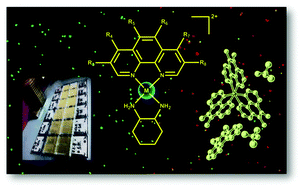Copper(II) (1CuCu–21CuCu) and previously established experimental anticancer platinum(II) metallointercalator complexes (1PtPt–16PtPt) have been prepared and investigated for their antimicrobial properties. These complexes are of the general structure [M(IL)(AL)]2+ where IL represents functionalised 1,10-phenanthrolines (1ILIL–10ILIL), and AL represents 1,2-diaminoethane, 1S,2S- or 1R,2R-diaminocyclohexane. The structures of synthesised complexes were confirmed using a combination of elemental analysis, UV spectrometry, circular dichroism, 1H and [1H–195Pt]-HMQC NMR, X-ray crystallography, and electrospray ionisation mass spectrometry and where appropriate. Crystallisation attempts yielded single crystals of [Cu(4-methyl-1,10-phenanthroline)(1R,2R-diaminocyclohexane)](ClO4)2 (4CuCu), [Cu(5,6-dimethyl-1,10-phenanthroline)(1R,2R-diaminocyclohexane)(H2O)](ClO4)2·1.5H2O (10CuCu) and [Cu(5,6-dimethyl-1,10-phenanthroline)3](ClO4)2·5,6-dimethyl-1,10-phenanthroline·2H2O (21CuCu). Growth inhibition of liquid cultures of bacteria (Staphylococcus aureus, Escherichia coli, and Pseudomonas aeruginosa), and yeast (Saccharomyces cerevisiae) discerned the most antimicrobially potent metal complexes ≤20 μM, as well as that of their intercalating ligands alone. To further investigate their mode of antimicrobial activity, membrane permeabilisation caused by selected complexes was visualised by means of a cell viability kit under fluorescence microscopy.


 Please wait while we load your content...
Please wait while we load your content...